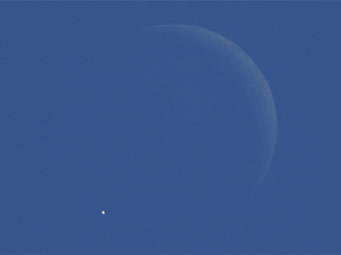
In daylight on June 18, 2007, Alan C. Tough in Scotland took this shot of Venus just before it was occulted by the dark limb of a thin waxing Moon. The Moon was much thicker (15% illuminated) and farther from the Sun than it will be on March 5th. Tough used a Canon EOS 300D camera with a 600-mm lens. Exposure: 1/320th second, f/6.3, ISO 100.
Alan C. Tough
The thin waning crescent Moon occults (covers) Venus during daylight on March 5, 2008, for central and western North America and Mexico. The bright little planet will disappear behind the Moon's bright edge (which may be invisible in the blue sky) and will reappear from behind the Moon's dark edge.
But "bright" is altogether the wrong word for any part of such a thin Moon (only 5% illuminated!) in the daytime sky. The Moon will be just 25° from the Sun, and lower than the Sun to boot. Venus, with its higher surface brightness, is surely what you'll notice in your telescope or finderscope first.
For the times of Venus's disappearance and reappeance as seen from your area, see the tables of predictions for hundreds of cities and towns prepared by the International Occultation Timing Association.
In the tables, the time of each event is given in Universal Time in hours, minutes, and seconds. To get Eastern Standard Time subtract 5 hours from this; for CST subtract 6 hours; for MST subtract 7 hours; for PST subtract 8 hours. The tables also give the altitudes of the Sun and Venus above your horizon at the time of the event (in degrees), and the azimuth of Venus: the compass direction around your horizon, counting eastward from true north. (Azimuth 270° is true west.) These directions will help a lot in finding Venus. In fact, if your sky is not crystal-clear blue, you may miss the Moon altogether even in a telescope!
 5
5









Comments
Jon R Zander
February 29, 2008 at 10:26 am
It looks like during the dawn, Mercury and Neptune will be in the area, too. I doubt I can catch Neptune in those conditions, but it would be fun to spy the two inferior orbit planets riding along with Luna.
You must be logged in to post a comment.
Curt Renz
February 29, 2008 at 10:51 am
And here's a special challenge for those who live near Los Angeles and would like to witness a grazing occultation of Venus. The northern graze path will sweep in a northeasterly direction from Topanga State Park through Palmdale to Lockhart.
Below is my algorithm for the northern graze path which passes slightly to the north of Los Angeles. It is only good between western longitudes 117.3° and 118.7°. Input and output are all decimal. A Western Longitude is the only input. The hour is in Pacific Standard Time. The Zenith Angle is the position of Venus on the lunar limb measured counterclockwise from the zenith.
W = Western Longitude as a positive decimal value
M = W - 118
Northern Latitude = 34.552472 - 0.784811 M - 0.011230 M²
Hour PST = 12.54922 - 0.02488 M - 0.00089 M²
Zenith Angle = 290.295 + 0.245 M + 0.026 M²
Venus Altitude = 32.528 + 1.292 M + 0.014 M²
I’ve created a North American graze map, also preview graphics and data for the location of Chicago’s Adler Planetarium. They can be seen at: http://www.CurtRenz.com/astronomical.html
You must be logged in to post a comment.
Jon R Zander
February 29, 2008 at 2:13 pm
I thought I noticed that while checking this over in my Starry Night software. I'll be watching from Boulder City, Nevada, so this should be a nice added bonus for me.
You must be logged in to post a comment.
Curt Renz
February 29, 2008 at 8:23 pm
First I apologize for the manner in which my algorithm was presented. I posted it in tabular form but S&T’s text editor compacted everything. The graze path will pass a little north of Las Vegas. Rather than post the algorithm, I’ll give you three points on the graze line. (W 115.7° , N 36.29720°) , (W 115.0° , 36.80625°) , ( 114.3° , 37.30512°) .
BTW, Mercury will be occulted a few hours earlier for some South Americans, and Neptune will be occulted a few hours later for some Australians and New Zealanders.
You must be logged in to post a comment.
SteveN
March 5, 2008 at 2:01 pm
There is a mild Santa Ana wind condition producing clear, high transparency skies. In spite of that and the excellent directions I wasn't able to spot the crescent moon or Venus in 8x42 binoculars. Lesson learned - set up one of the goto scopes the night before. Discovery - there's an amazing number of plastic grocery bags that fly over Los Angeles at high altitude during Santa Ana wind conditions.
You must be logged in to post a comment.
You must be logged in to post a comment.